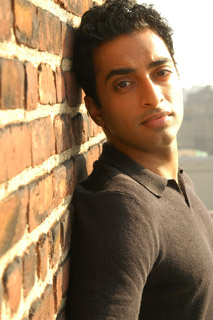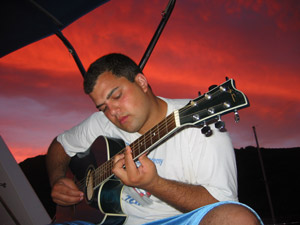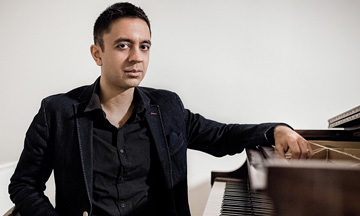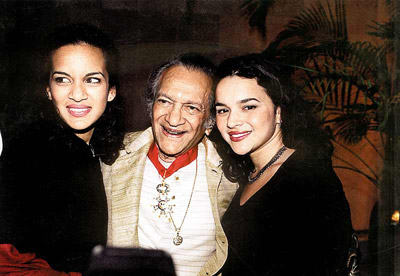ALCHEMISTS OF SOUND

Jay Sean was at Capital FM music station about to do an interview, when a woman he had travelled with burst in, looking ridiculously excited and said, ‘Congratulations, you’ve got a number one record in America!’
“I was ecstatic. I started jumping up and down, I was so happy,” said the lean, chiseled R&B singer-songwriter of Sikh descent, whose real name is Kamaljit Singh Jhooti.
Sean bounced the Black Eyed Peas off the No.1 spot on the Billboard Hot 100 in October 2009 with his up-tempo single “Down.” It was a dramatic turnaround of fortunes for an Indian singer who, just a couple of years ago, was let go by his U.K. record label. “Down” went platinum in several countries and sold four million copies in America. For Sean, making U.S. chart history capped years of touring like a fiend, playing over 2,000 gigs, and grinding hard at the Asian festival and nightclub circuit where hard-to-please audiences sometimes threw bottles at him.
After his U.S. chart-topping success, Sean went on to duet with Justin Timberlake and Nicki Minaj, appearing on all the biggest American TV shows and sparking paparazzi frenzy globally whenever he arrived at airports, restaurants, and concert venues.
No Indian origin musician has achieved that level of stardom since the death of Mumbai-born Freddie Mercury (aka Farrokh Bulsara), lead vocalist of the iconic, 1970s British rock n’ roll band Queen and Asia’s first global rock star. Sean’s meteoric rise in the U.S. music industry now comes as a pleasant surprise.
Sean’s success spotlights other Indian artists making a name for themselves in the hard-as-nails U.S. music industry like jazz pianist Vijay Iyer, hip-hop star Sen, actor-singer Manu Narayan and Rupa Marya, the ebullient lead singer and front woman of Rupa & The April Fishes.
 Jay Sean (aka Kamaljit Singh Jhooti) bounced the Black Eyed Peas off the No.1 spot on the Billboard Hot 100 in October 2009 with “Down,” his up-tempo single
Jay Sean (aka Kamaljit Singh Jhooti) bounced the Black Eyed Peas off the No.1 spot on the Billboard Hot 100 in October 2009 with “Down,” his up-tempo single
Multicultural Music
Based in the colorful San Francisco Bay Area, Rupa & the April Fishes creates music that defies easy categorization. Their albums, eXtraOrdinary rendition (2008), Este Mundo (2009), Build (2012) and Live at The Independent (2014), brim with Argentinean tango, Gypsy swing, American folk, Latin cumbias and even hints of Indian ragas. Billed as “one of the hottest emerging acts” by Time Out, Rupa & the April Fishes have performed hundreds of sold-out concerts in iconic venues.
Songwriter and band leader Rupa Marya––she’s also a doctor of internal medicine on faculty at UCSF––has an extraordinary ear for languages and writes in many, including French, Spanish, Hindi and English.
“I think it’s because my family moved so much and I was constantly exposed to several languages as a child. Language is musical and mathematical. And my mind tends to enjoy both of those things. I am not a language expert but I do love building and crossing bridges, and learning another’s language is a good place to start,” Rupa said after a high-octane concert at the magnificent Bell House in Brooklyn.
 Broadway actor and musician Manu Narayan: “We have this Balkan gypsy rhythm, Indian melody and Western beats…”
Broadway actor and musician Manu Narayan: “We have this Balkan gypsy rhythm, Indian melody and Western beats…”
“I would describe our sound as the kind of music you’d hear at a bazaar where several streets from several countries from around the world intersected at one point. We’d be at that spot, getting the party started. I call it global music, the sound of people with global identities making music, drawing from our different roots,” she added.
 Rupa Marya of Rupa and the April Fishes. (Photos: Judith Burrows)
Rupa Marya of Rupa and the April Fishes. (Photos: Judith Burrows)
Neo World Rock
Broadway actor and musician Manu Narayan is the very model of a cosmopolitan Indian American and has the intellectual pedigree (educated at Carnegie Mellon) for a fast-changing world. Narayan is a classical saxophonist steeped in western and South Indian Carnatic styles.
“I have lived in India and studied with a guruji so I am familiar with the guru-shishya practice. I studied the saxophone with Kadri Gopalnath for a year in India. It was an incredible experience,” Narayan told me when he was promoting the Mike Myers comedy The Love Guru where he co-stars as Rajneesh alongside Jessica Alba, Justin Timberlake, and Sir Ben Kingsley.
Narayan impressed A.R. Rahman enough with his classical music training, singing and energetic dancing to land the lead role as Akaash in Rahman and Andrew Lloyd Webber’s $14 million Broadway musical Bombay Dreams, where he lit up the stage with his singing. Set to a bhangra beat, Bombay Dreams was as big and as splashy as the 32-nozzle fountain that showered Narayan and the cast during Shakalaka Baby.
It was “exciting” to be doing Rahman’s music, Narayan reflected. “It’s world pop. It’s beautiful, lush, cutting-edge, and catchy.”
Narayan has toured in Miss Saigon, and appeared in Les Miserables, Two Gentlemen of Verona, Glengarry Glen Ross, Metamorphoses and Romeo and Juliet (as Romeo). Theater audiences mesmerized by Narayan’s powerful singing on stage have gravitated to his albums.
“Our band, Darunam, brings Eastern melody with Indian melody. My partner Radovan Jovicevic is a Serbian rock star who founded the multi-platinum selling group Zana which toured all over Eastern Europe. We have this Balkan gypsy rhythm, Indian melody and Western beats,” said Narayan.
Critics say Narayan’s fusion music will please fans of Trilok Gurtu and the more recent works of Peter Gabriel. There is a jazz-rock-world music fusion sound behind his band Darunam’s albums like The Last Angel on Earth. The band combines the distinctive rhythms and melodies of America, India, and the Balkans to form “Neo World Rock” — unique modern rock/pop with a world beat groove, and a sound undeniably their own.
“Our albums are more Buddha Bar—a soundtrack to our life,” says Narayan.
Narayan’s 2007 single All that’s Beautiful Must Die, is a powerful track with passionate vocals and a catchy chorus. It was a blockbuster hit on U.S. radio stations. Narayan is also man-candy in popular TV shows like The Sopranos and Law and Order.
Breaking Barriers
Making it as a serious musician in the U.S. has always been the longest of career long shots. And Indian musicians in America have often had to contend with the disapproval of their own communities, which frown on risky careers in the arts.
“My father was supportive of me following my dreams, but as an Indian parent, he felt that medicine was a safer investment than music. Typically, Indian parents (especially Indian immigrant parents) don’t see careers in the arts as a good idea,” said Rupa.
“Eventually my family became a huge support for what I do. As I found my voice more in music, their support grew,” added Rupa, who dedicated Yaad to her late father.
Nothing could have prepared Nobel-winning Harvard professor Amartya Sen for a son who is famous in his own right in a world thrice removed from the rarefied groves of academe. But hip-hop star Kabir Sen says his father played a whimsical role in his musical destiny.
 Hip-hop star Kabir Sen, and one of the genre’s finest wordsmiths. (Photo: Rebecca Foy)
Hip-hop star Kabir Sen, and one of the genre’s finest wordsmiths. (Photo: Rebecca Foy)
“I started playing the piano when I was four and I considered quitting by the time I was 12 because I was tired of practicing the scales. He talked me out of it and told me that if I stuck with it, I would not regret it—he was right, of course!” says Kabir, who graduated from liberal arts institution Wesleyan University, in Connecticut, with an Honors degree in Music.
Kabir praises his father for putting forward “no argument” when Kabir chose to study music, or when he veered onto the rap path.
“He does not know much about hip-hop per se, but I think that my father appreciates the lyrical and message-oriented content of my music. He knows that people have recognized my music at various levels and I guess this has helped him to adjust to the fact that I am not in academia.”
Kabir, however, is still in the school system. He has a frenetic life as a recording and performing artist, producer, and music teacher at his alma mater Shady Hill School in Cambridge, Massachusetts. He teaches both a seventh/eighth grade rock band and hip-hop class. He also teaches third and fourth grade general music and is in charge of all the class plays.
A passionate teacher, Kabir threw himself into writing an original musical, True Courage: A Whaling Adventure, set in the 1850s, for his third graders since their year-long study centered around whales.
“I wrote a musical about the story of a boy who grows up on his father’s whaling ship. Everyone on board wants the boy to become his father’s successor as the next whaling captain, but the trouble is that the boy is infatuated with whales and desperately wants no harm done to them. The boy ends up devising a massive charade in which he pretends to want to learn from his father about how to hunt whales, but then out at sea he intentionally sabotages the whaling efforts of the crew,” says Kabir.
Kabir continues to teach hip-hop education workshops as a visiting artist at many other schools, and remains heavily entrenched in giving private lessons in piano, guitar, drums, music production, songwriting, music theory, and rhythm training.
“Conveying my passion for music is a blessing and I continue to love the crafts of both music and teaching which is why I continue to fuse the two together,” says Kabir.
As an 8–year–old growing up in London, Kabir suddenly lost his Italian-Jewish mother Eva Colorni, who was also a brilliant economist, to cancer. Amartya Sen wanted to take his young children— Indrani and Kabir––to another country where they would not miss their mother constantly. So he started teaching Economics at Harvard. Kabir picked up the university town’s musical vibe.
In his last year of primary school, Kabir was part of a rock band that performed as street musicians in Harvard Square. The elder Sen would cross the square en route to class. “He probably thought it was too loud,” Kabir said, “but he stood there tapping his foot.”
“Kabir has always been certain about what he wants,” said elder sister Indrani, a journalist in New York. “When he was a kid he played all sorts of instruments—piano, guitar and briefly the violin, which was not a very great phase for us.”
Conscious Rap
All five of Kabir’s albums—Cultural Confusion (2001), Fuel for the Fire (2003), Peaceful Solutions (2006), The Time is Now (2010), and Olympic Gold (2012)––have a distinctive sound and identity.
Kabir is now working on a new album titled No More Excuses. “I am finishing up my sixth album this summer (mostly recorded, still getting it mixed and mastered)—it’s a Beatlesy-influenced mix of soul, rock n’ roll and hip-hop,” says Kabir.
In 2001, two years after he graduated from college, Kabir made the cover of Billboard magazine for his first, self-produced album. Not surprisingly, Cultural Confusion was a journey of self-discovery and drew on his early, rapid exposure to several cultures—Indian, Italian, British, and American. The second album, Fuel for the Fire, has a more universal theme with tracks on love, hate, and jealousy.
“Both my themes come together in Peaceful Solutions. It is also about re-channeling negative energy and the power of respect, kindness, and positive thinking,” says Kabir, “There are different musical styles on the album: funk, soul, blues, and Indian music are all prevalent and hip-hop is the sound that sort of ties it all together.”
“I grew up listening to Indian music, particularly the music of Ravi Shankar, Ali Akbar Khan, and Zakir Hussein. My grandmother bought me a tabla when I was in high school which opened up a whole new world of rhythmic interests. I also studied South Indian vocal music at Wesleyan, with the late T. Viswanathan.”
Kabir, who was featured in Raeshem Nijhon’s hip-hop film Brown Like Dat with artists including Chee Malabar from Himalayan Project, D’Lo, Jugular, and Karmacy, has come to represent a breakout generation of South Asian hip-hop artists with a growing fan base.
“The main departure Kabir brings to hip-hop and rap is to be constructive and integrative without losing the force of subversion which gives this type of music its power,” says Amartya Sen, who is among the world’s most celebrated activist-intellectuals. “Rather than using that subversion for violence and conflict, he goes for peace and construction. It is not smug music about the world —it seeks change,” says Sen.
Sen is dead right about his son’s world-changing ambitions. A liberal intellectual, Kabir has written raps on themes hardly touched on in hip-hop: Middle East peace, nuclear nonproliferation, and corruption. He is a rapper who avoids vulgarities, and laces his lyrics with fiery, thoughtful writings to address important currents in American culture. A devoted husband, and father to young girls, Kabir is one of hip-hop’s finest wordsmiths.
Kabir’s new album, No More Excuses, again delves into themes that are deeply personal for the family man. The album, which has a classic soul/live band feel, is slated for a Fall release.
“The ten songs are about a number of subjects: The most prominent themes are love and family (there are several love songs as well as a tribute to my 3–year–old Julia), but there are also lyrics about ambition, personal conflict and inhibitions, the natural feelings inspired by music, and the polarization of politics in America,” says Kabir.
All That Jazz
Two years ago, The Huffington Post exuberantly described Vijay Iyer as “America’s greatest living jazz pianist.” Today, composer and pianist Iyer may be counted as one of the leading figures in contemporary jazz, but he wasn’t always as widely accepted.
For many years, jazz listeners and critics didn’t know what to make of Iyer’s music. He was terribly unconventional: the fearless jazz improvisations of American pianist Thelonious Monk met the undulating rhythmic intricacies of Carnatic music in his staggeringly prolific work. Music is normally created with the intention of projecting a potent and recognizable identity; and Iyer firmly melded his influences— Indian and American.
“When people see difference, they can get blinded or deafened by that perception of difference,” Iyer told SPAN magazine.
“I’m not complaining; that was just my experience. If you’re doing something that’s a little bit against the grain or pushing the envelope or offering some-thing new, then you’re always on the margins of acceptance.”
There just aren’t too many Indians involved in the jazz scene, and Iyer sees that as partly responsible for contributing to the degree of novelty surrounding his music. “There just haven’t been Indian Americans performing jazz before my generation because of immigration law. People like my parents couldn’t come to the United States before the mid-1960s, so none of this existed before my generation was born,” said Iyer.
Iyer’s 2004 album, In What Language? for example, combines jazz influences with hip-hop and a spoken-word performance by Australian poet Mike Ladd, drawing on musical traditions from South Asia and Africa. Iyer says he and Ladd created the song cycle album about airports, fear, and surveillance after 9/11 as an examination of diversity and tolerance.
Iyer’s unique sound has catapulted him to the top in jazz magazine polls. He has won the Alpert Awards in the Arts and a MacArthur Foundation fellowship or the so-called “genius” grant valued at $625,000. In 2014, he became Franklin D. and Florence Rosenblatt Professor of the Arts at Harvard University.
Iyer holds an undergraduate degree in mathematics and physics from Yale University. He attended the University of California, Berkeley, initially to pursue a doctorate in physics.
 The terribly unconventional Vijay Iyer, known for his the fearless jazz improvisations of American pianist Thelonious Monk.
The terribly unconventional Vijay Iyer, known for his the fearless jazz improvisations of American pianist Thelonious Monk.
Iyer frequently collaborates with other South Asian musicians including guitarist Rez Abbasi, saxophonist Rudresh Mahanthappa, guitarist Prasanna, and violinist L. Subramaniam who, like Iyer, have been working with Carnatic and jazz music in America. Iyer’s collaboration with saxophonist Rudresh Mahanthappa has resulted in five well known albums: Architecture (1998), Panoptic Modes (2001), Blood Sutra (2003), Reimagining (2005), and Tragicomic (2008).
Iyer radiates warmth and intelligence and is completely unassuming about making waves in the rarefied world of avant-garde jazz. “I’ve been doing a lot of what I want to do,” says Iyer. “I’ve worked hard, made many albums, and some of them have had a pretty big impact, which is more than I expected. It has opened doors for me. I feel blessed.”
SIDEBAR
Norah Jones: The Reluctant Diva
Raven haired singer-songwriter Norah Jones has sold millions of albums which have made her almost too popular for the intimate theaters she prefers to sold-out arenas. But a few weeks ago, the petite 9-time Grammy winner bowled over the Thursday night crowd at the Bowery Electric in New York with a surprise performance with Green Day frontman Billie Joe Armstrong.
After the properly surprised and thrilled crowd stopped exulting, Jones and Armstrong eased into Roving Gambler, strumming acoustic guitars and settling into the kind of dusty, smoky harmonies perfect for tragic tales of no-good card sharks.
The exact opposite of a diva, everything about Jones is a revelation. In 2002, she dropped a surprise—her debut album Come Away with Me—on American music listeners, a mellow, acoustic pop with jazz, country, and soul album that instantly went platinum. “In a pop universe full of whiz-bang electronic bombast and frantic vocal acrobatics, Jones arrived like an emissary from some subtler dimension,” declared The New York Times. Jones swept five Grammys for Come Away with Me including best album, song, record of year, and best female pop vocal performance.
Jones and Anoushka Shankar inherited their famous father, Ravi Shankar’s musical talent, and have carved out thriving careers of their own.
Shankar influenced musicians from George Harrison to John Coltrane, from Yehudi Menuhin to David Crosby. He also pioneered the concept of the modern megastar rock benefit with the 1971 Concert for Bangladesh. During the height of the countercultural music revolution of the 1960s, he also was in the lineup at the Woodstock music festival. But now, to most Americans, Shankar is best known as Jones’ father.
Shankar had a notoriously complicated private life. In the course of his touring, Shankar had a relationship with concert promoter Sue Jones. The couple, in 1979, had a daughter named Geethali Norah Jones Shankar. When she turned 16, Jones changed her name to Norah Jones. Shankar never married Sue Jones and the affair was short-lived. Jones has always been guarded about her desultory childhood contact with her Indian father.
“I knew who my dad was,” she told CBS television anchor Katie Couric on 60 Minutes. “I saw him sporadically until I was nine and then I didn’t see him again or talk to him until I was 18.” Her mother, Jones said, didn’t want her talking about him so it was “kind of a secret.”
However, when Jones turned 18 she reached out to her father, who was living in California with his other daughter musician Anoushka Shankar and second wife. When Couric asked Jones if she was angry or sought an apology from her father when they picked up the thread of their relationship after nine years, Jones was candid, “Yeah. I might have. I might have wanted that.”
 Anoushka Shankar (left) and Norah Jones (right) with their late father Ravi Shankar.
Anoushka Shankar (left) and Norah Jones (right) with their late father Ravi Shankar.
Jones pointedly thanked her mother when she won multiple Grammys for Come Away With Me in 2003. She said she was raised by a single mom who “sacrificed to give her every opportunity like piano lessons.”
Jones said her “musical roots” are country and jazz, tastes acquired growing up in Grapevine, Texas, listening to her mother’s “eclectic record collection.”
Drawn to jazz, Jones majored in piano at the pioneering jazz studies department of the University of North Texas before dropping out and heading to New York City where like most budding musicians in the Big Apple, she waited tables and played gigs in jazz clubs. She was only 23 when she became a surprise multiplatinum sensation with her debut Grammy-winning album Come Away with Me which sold over 20 million copies.
In 2005, Shankar, who Harrison described as “the godfather of world music”, beamed with pride as both his gifted daughters, Jones, then 26, and Anoushka, who was two years younger, both were nominated for Grammy awards. He was lucky that they had been shortlisted in different categories.
All five of Norah Jones’ albums—Come Away With Me (2002), Feels Like Home (2004), Not Too Late (2007), The Fall (2007), and Little Broken Hearts (2012)—are filled with wistful longing and, tucked behind it, the serene assurance that she will never have to shout for attention. Jones has also starred in the road movie My Blueberry Nights.
Uttara Choudhury is a contributing writer at Forbes India, an editor (North America) at Firstpost.com, and a consulting editor at BrainGain Magazine.
Enjoyed reading Khabar magazine? Subscribe to Khabar and get a full digital copy of this Indian-American community magazine.
blog comments powered by Disqus










